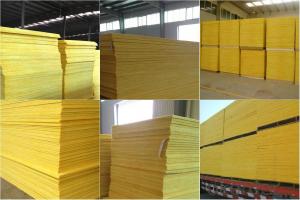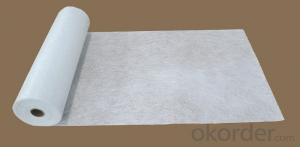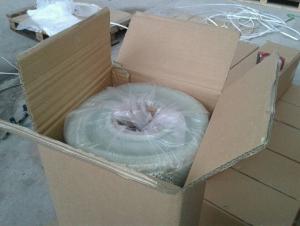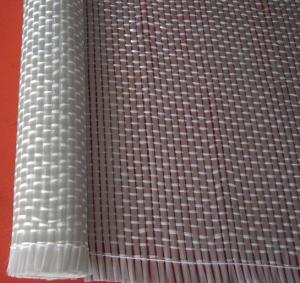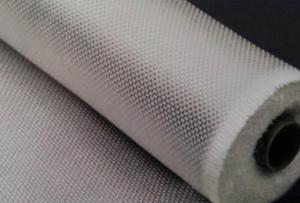E-Glass/C Glass Fiberglass Mat Tissue Woven Roving
- Loading Port:
- Shanghai
- Payment Terms:
- TT or LC
- Min Order Qty:
- 16000 kg
- Supply Capability:
- 160000Kg Per Month kg/month
OKorder Service Pledge
OKorder Financial Service
You Might Also Like
1.Brief Introduction
Woven Rovings are compatible with unsaturated polyester, vinyl ester, epoxy and phenolic resins.
Woven Rovings are a high-performance reinforcement widely used in hand lay up and robot processes to manufacture boats, vessels, plane and automotive parts, furniture and sports facilities.
2.Product Features
Warp and weft rovings aligned in a parallel and flat manner, resulting in uniform tension
Densely aligned fibers, resulting in high dimensional stability and making handling easy
Good moldability, fast and complete wet out in resins, resulting in high productivity
3.Product Specifications
Property | Area Weight | Moisture Content | Size Content | Width |
(%) | (%) | (%) | (mm) | |
Test Method | IS03374 | ISO3344 | ISO1887 | |
EWR200 | ±7.5 | ≤0.15 | 0.4-0.8 | 20-3000 |
EWR270 | ||||
EWR300 | ||||
EWR360 | ||||
EWR400 | ||||
EWR500 | ||||
EWR600 | ||||
EWR800 |
Special specification can be produce according to customer requirements.
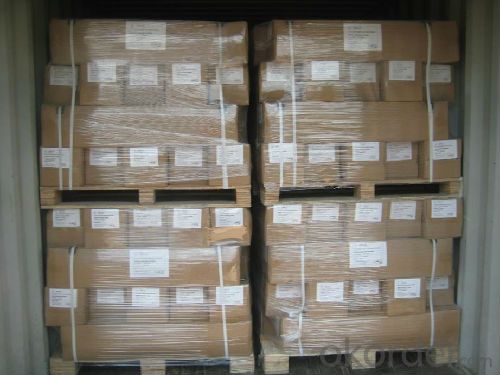
4.FAQ
Packaging:
Each woven roving is wound onto a paper tube which has an inside diameter of 76mm and the mat roll has a diameter of 220mm. The woven roving roll is wrapped up with plastic film,and then packed in a cardboard box or wrapped up with kraft paper. The rolls can be horizontally placed. For transportation, the rolls can be loaded into a cantainer directly or on pallets.
- Q: How is fiberglass mat tissue used in the production of windshields?
- The unique properties and functions of fiberglass mat tissue make it a crucial component in windshield production. To strengthen and increase the durability of the glass, manufacturers use fiberglass mat tissue as a reinforcement material. In the manufacturing process, a layer of fiberglass mat tissue is inserted between two layers of glass to create a laminated structure. This layer acts as a barrier, preventing the glass from shattering upon impact and holding it together for the safety of the vehicle occupants. By serving as a reinforcing material, fiberglass mat tissue improves the mechanical properties of the windshield. It enhances the impact resistance, reducing the likelihood of cracks or chips caused by stones, debris, or other objects. This reinforcement also provides structural integrity, allowing the windshield to withstand extreme weather conditions and vibrations without affecting its functionality. Moreover, fiberglass mat tissue aids in reducing noise transmission and vibrations. Its sound-damping properties contribute to a quieter and more comfortable driving experience by minimizing external noise from entering the vehicle cabin. Additionally, the use of fiberglass mat tissue enables the production of curved windshields. The material's flexibility allows it to conform to different shapes and contours, enabling manufacturers to create windshields with customized designs and improved aerodynamics. In conclusion, fiberglass mat tissue plays a vital role in windshield production. Its reinforcement properties enhance the strength and impact resistance of the glass, ensuring the safety of vehicle occupants. It also contributes to a quieter driving experience and enables the production of curved windshields with improved aerodynamics.
- Q: Can fiberglass mat tissue be used for swimming pool construction?
- Yes, fiberglass mat tissue can be used for swimming pool construction. Fiberglass mat tissue is a versatile material that is commonly used in the construction industry for its strength, durability, and resistance to water and chemicals. It is often used as a reinforcement material for swimming pool shells, providing added structural integrity and preventing cracking or leaking. Additionally, fiberglass mat tissue is lightweight and easy to work with, making it a popular choice for pool builders. However, it is important to ensure that the fiberglass mat tissue used for swimming pool construction meets the necessary standards and regulations to ensure the safety and longevity of the pool.
- Q: Can fiberglass mat tissue be used for flooring applications?
- Yes, fiberglass mat tissue can be used for flooring applications. Fiberglass mat tissue is a thin, non-woven fabric made from glass fibers. It is lightweight, flexible, and has excellent strength and durability. These properties make it suitable for various flooring applications. Fiberglass mat tissue can be used as a reinforcement layer in flooring systems, such as vinyl or linoleum flooring. It provides added strength and stability to the flooring, preventing it from cracking or warping over time. The mat tissue is typically embedded in a layer of adhesive or resin, creating a strong bond between the flooring material and the subfloor. Additionally, fiberglass mat tissue can be used as an underlayment for flooring installations. It acts as a barrier between the subfloor and the flooring material, providing insulation, soundproofing, and moisture resistance. This helps to protect the flooring from moisture damage, reduce noise transmission, and maintain a comfortable indoor environment. Overall, fiberglass mat tissue is a versatile material that can enhance the performance and longevity of flooring applications. Its strength, flexibility, and resistance to moisture make it a suitable choice for various flooring systems, providing added stability, durability, and comfort.
- Q: How does fiberglass mat tissue compare to polystyrene insulation?
- Fiberglass mat tissue and polystyrene insulation serve different purposes as insulation materials, each with their own unique characteristics and advantages. Fiberglass mat tissue is composed of woven strands of glass fibers that form a mat. It is commonly used for heat and sound insulation. This material is known for its exceptional thermal insulation properties, effectively resisting heat transfer in both hot and cold environments. Additionally, it is resistant to moisture and does not facilitate the growth of mold or mildew. On the other hand, polystyrene insulation is a foam material made from expanded polystyrene beads. It is widely used in construction due to its ability to provide efficient thermal insulation and its adaptability to different spaces through shaping or cutting. Polystyrene insulation is recognized for its high compressive strength, making it ideal for applications requiring support. It is also lightweight, resistant to moisture, and exhibits excellent durability. When comparing fiberglass mat tissue to polystyrene insulation, several notable differences should be considered. Fiberglass mat tissue is generally more flexible and easier to install on irregular or curved surfaces. Moreover, it offers superior fire resistance, as it does not burn or emit toxic gases when exposed to flames. However, fiberglass mat tissue tends to be more expensive than polystyrene insulation and may necessitate additional protective measures during installation, such as gloves and masks, due to potential skin and respiratory irritation. Conversely, polystyrene insulation is more cost-effective and simpler to handle and install compared to fiberglass mat tissue. It also exhibits enhanced resistance to moisture, making it suitable for applications in humid environments or areas prone to water exposure. Nevertheless, polystyrene insulation is more flammable than fiberglass mat tissue and releases toxic gases when burned. In conclusion, the choice between fiberglass mat tissue and polystyrene insulation depends on the specific requirements of the insulation project. Fiberglass mat tissue excels in thermal insulation, fire resistance, and resistance to moisture and mold. On the other hand, polystyrene insulation offers efficient thermal insulation, ease of installation, and high compressive strength. Ultimately, factors such as cost, installation requirements, fire resistance, and moisture resistance should be carefully considered when selecting between fiberglass mat tissue and polystyrene insulation.
- Q: How is fiberglass mat tissue used in the aerospace industry?
- Fiberglass mat tissue is used in the aerospace industry primarily for its lightweight and high strength properties. It is commonly used as a reinforcement material in the manufacturing of aircraft components such as wings, fuselage, and tail structures. The fiberglass mat tissue provides structural integrity and enhances the overall durability of these components, while also offering excellent resistance to corrosion and high temperatures.
- Q: What are the potential environmental impacts of using fiberglass mat tissue?
- The potential environmental impacts of using fiberglass mat tissue can vary depending on several factors. One potential impact is the extraction and production of the raw materials needed to manufacture fiberglass. The process of obtaining glass fibers involves mining and processing silica sand, which can lead to habitat destruction, soil erosion, and water pollution. Additionally, the production of glass fibers requires a significant amount of energy, which often comes from non-renewable fossil fuels, contributing to greenhouse gas emissions and climate change. Another environmental impact of using fiberglass mat tissue is the release of hazardous chemicals during the manufacturing process. Fiberglass production involves the use of resins, binders, and other chemicals that can be harmful to human health and the environment. These chemicals may be released into the air, water, or soil, potentially contaminating nearby ecosystems and posing a risk to wildlife and human populations. Furthermore, the disposal of fiberglass mat tissue at the end of its life cycle can also have environmental implications. Fiberglass is not easily biodegradable, and proper disposal methods are crucial to prevent it from ending up in landfills or being incinerated, both of which can release harmful substances into the environment. Recycling fiberglass can be challenging due to its complex composition, leading to a significant portion of it being discarded improperly. Lastly, the use of fiberglass mat tissue in certain applications, such as insulation or construction materials, can contribute to energy consumption and greenhouse gas emissions. For example, fiberglass insulation can require additional energy for manufacturing, transportation, and installation compared to alternative insulation materials like cellulose or mineral wool. In conclusion, the potential environmental impacts of using fiberglass mat tissue are diverse and range from habitat destruction and pollution during raw material extraction to the release of hazardous chemicals during manufacturing and difficulties in disposal and recycling. It is essential for manufacturers and consumers to consider these impacts and explore alternative materials and production processes that minimize harm to the environment.
- Q: How does fiberglass mat tissue perform in terms of moisture vapor resistance?
- Fiberglass mat tissue is generally effective at resisting moisture vapor. It acts as a barrier, preventing the passage of water vapor and making it suitable for moisture control in applications like roofing and insulation. To enhance the moisture vapor resistance of fiberglass mat tissue, it can be combined with other materials like vapor barriers or moisture-resistant coatings. These additional layers provide extra protection against moisture infiltration, improving the overall performance of the fiberglass mat tissue. However, it should be noted that the moisture vapor resistance of fiberglass mat tissue can vary depending on factors such as thickness, density, and composition. Thicker and denser mats tend to offer higher resistance, while the presence of manufacturing additives or coatings can also affect the material's properties. In conclusion, fiberglass mat tissue is known for its moisture vapor resistance, but its performance may be influenced by various factors. It is recommended to consult product specifications or manufacturers' recommendations to determine the specific moisture vapor resistance of a particular fiberglass mat tissue product.
- Q: Can fiberglass mat tissue be used for repairing fiberglass tanks?
- Fiberglass tanks can be repaired using fiberglass mat tissue. This type of tissue is a flexible and thin material commonly utilized in the construction and fixing of fiberglass items. Its purpose is to provide reinforcement and enhance the strength of the repaired sections. By using the appropriate resin, cracks, holes, or damaged areas in fiberglass tanks can be effectively restored with fiberglass mat tissue. Nonetheless, it is crucial to execute the repair in a meticulous and expert manner, adhering to the manufacturer's instructions and guidelines. Seeking advice from a fiberglass repair specialist or expert is highly recommended to achieve the optimal repair outcome.
- Q: How is fiberglass mat tissue different from fiberglass cloth?
- Fiberglass mat tissue and fiberglass cloth differ primarily in their construction and application. Fiberglass mat tissue is a non-woven material made of randomly oriented glass fibers bonded together with a binder. It is typically thinner and lighter than fiberglass cloth. Mat tissue is commonly used as a reinforcement layer in composite materials, providing strength and stability. On the other hand, fiberglass cloth is a woven fabric made of individual glass fibers arranged in a grid-like pattern. It is generally thicker and heavier compared to mat tissue. Fiberglass cloth is commonly used for applications requiring high strength and stiffness, such as boat building, aerospace, and automotive industries. In summary, the key differences between fiberglass mat tissue and fiberglass cloth lie in their construction, weight, and intended application. Mat tissue is a non-woven, lighter material used for reinforcement, while cloth is a woven, heavier fabric suitable for applications requiring high strength.
- Q: How does fiberglass mat tissue compare to cellulose insulation?
- Fiberglass mat tissue and cellulose insulation differ in terms of material composition and insulation properties. Fiberglass mat tissue is made from fine glass fibers, while cellulose insulation is composed of recycled paper fibers treated with fire-retardant chemicals. Fiberglass mat tissue offers higher R-value, meaning it provides better thermal insulation and energy efficiency. Additionally, it is resistant to moisture and does not promote mold growth. On the other hand, cellulose insulation is more affordable, environmentally friendly, and provides better sound insulation. Ultimately, the choice between the two depends on specific insulation needs, budget, and environmental considerations.
Send your message to us
E-Glass/C Glass Fiberglass Mat Tissue Woven Roving
- Loading Port:
- Shanghai
- Payment Terms:
- TT or LC
- Min Order Qty:
- 16000 kg
- Supply Capability:
- 160000Kg Per Month kg/month
OKorder Service Pledge
OKorder Financial Service
Similar products
Hot products
Hot Searches
Related keywords











